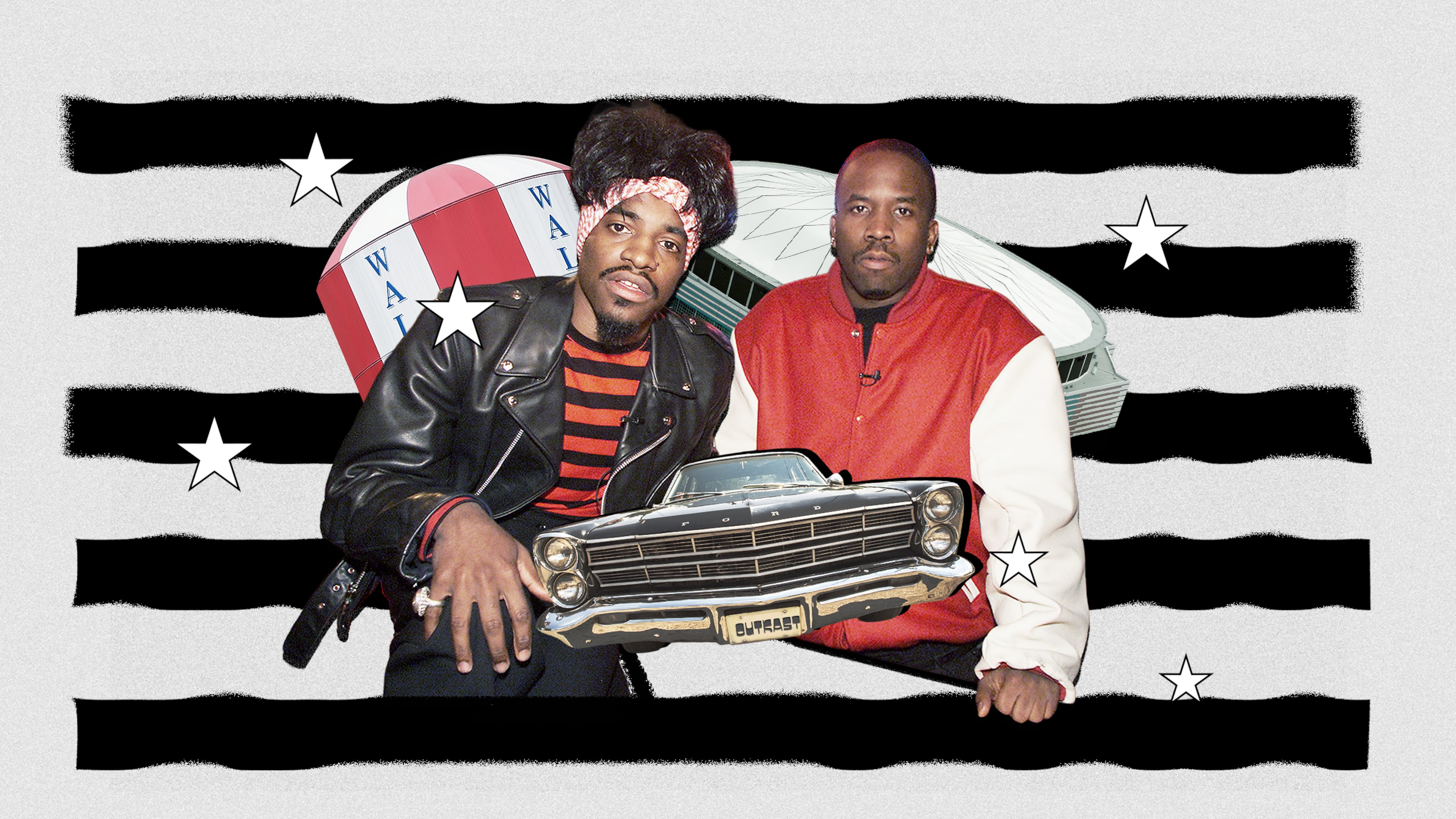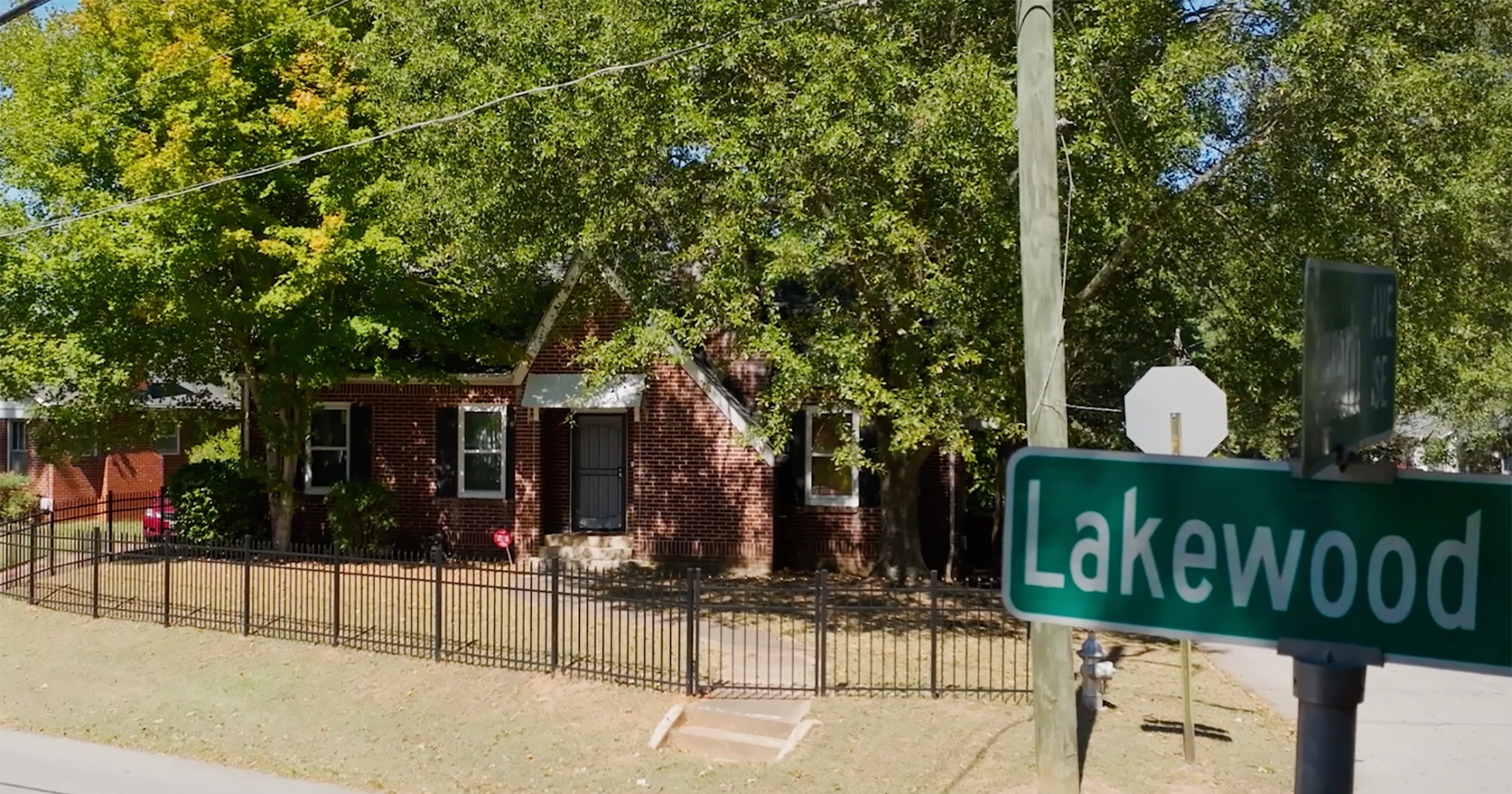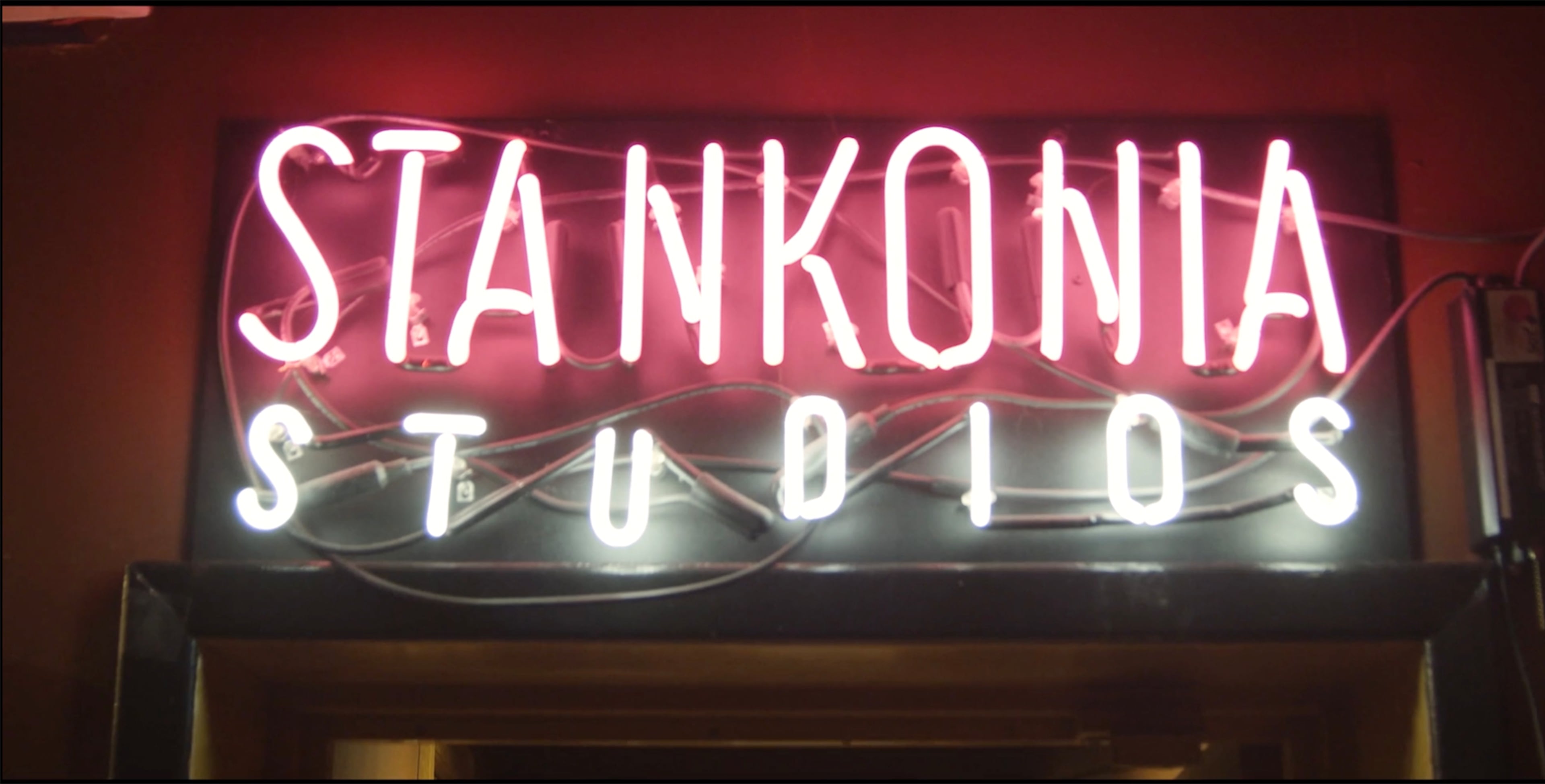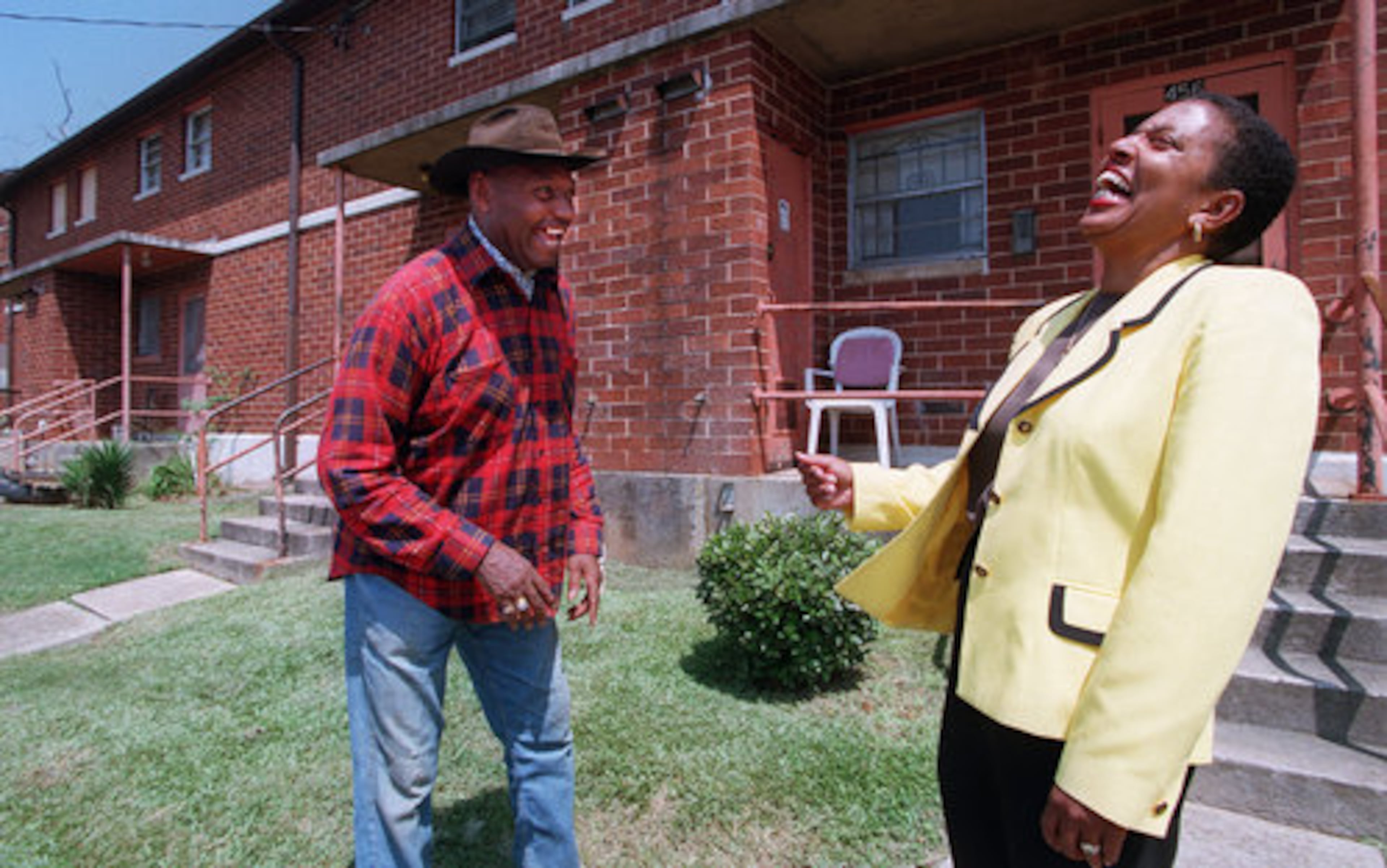Can we take you on a funky ride? Your guide to Outkast’s Atlanta

Three decades before it was cool to be an Atlanta native (or transplant), Andre 3000 and Big Boi were just two dope boys in a Cadillac cruising in the A-T-L.
The duo calling themselves Outkast rapped song lyrics with heavy Southern accents that exposed listeners to suburbs, streets, communities, businesses and landmarks synonymous with Atlanta’s history and culture.
They would eventually become a Grammy-winning group with the highest-selling rap album of all time. On Nov. 8, Outkast will be inducted into the Rock and Roll Hall of Fame in a class that includes Chubby Checker, Cyndi Lauper and Soundgarden. In the lead-up to the duo’s induction, the Atlanta Journal-Constitution and UATL are releasing a series of stories celebrating their legacy.
Here’s a breakdown of landmarks Outkast spotlights in their music, spaces they inhabited and tributes that honor their legacy.

Spaghetti Junction
Whether you’re coming to or leaving Atlanta, chances are you’ve navigated Spaghetti Junction. Spaghetti Junction, the nickname for the Tom Moreland Interchange, is the overlapping, squiggly knot where drivers switch between interstates 85 and 285.
The name is also one of the tracks off OutKast’s 2000 album “Stankonia” that forewarns travelers about how to navigate inside of the city limits.

The Dungeon
“Ain’t no thang but a chicken wing;
We’s having a smoke out in the Dungeon with the Mary Jane.”
— Big Boi, “Ain’t No Thang” (1994)
The Dungeon is the home recording studio in Lakewood Heights where Outkast and the Dungeon Family collective first made music. It was an unfinished basement in the family home of Dungeon Family and Organized Noize founding member Rico Wade. The moniker is a nod to the dank atmosphere, red clay floors and musical equipment with exposed wiring that made up the space.
Now owned by Big Boi, the house is available for rent through Airbnb. The two-bedroom home has been redecorated with plush furniture, studio equipment, music plaques and framed artwork.

Stankonia Studios
After the success of Outkast’s first two albums, the pair upped the ante by buying their own creative space, Stankonia Studios, in March 1998. The recording studio off Northside Drive was originally called Bosstown Recording Studios and belonged to R&B singer Bobby Brown.
The complex, which shares its name with the rap duo’s genre-defying fourth album, has served as a creative recording space for artists Aretha Franklin, Elton John and Rick Ross, among others. Big Boi has been Stankonia’s sole owner since Andre 3000 sold him his shares after the pair’s reunion and festival performances in 2014.

Tri-Cities High School
“I got an ounce of dank and couple of drinks, so let’s crank up a session;
Like Tri-Cities High School was pulling ‘em in a broke down rabbit;
I spit a couple of words, and laying ‘em down was just a habit.”
— Big Boi, “Ova Da Wudz” (1996)
Tri-Cities High School is the public school in East Point where the rap duo met as sophomores in the early 1990s. Andre dropped out, but Big Boi graduated with honors.
Known for its visual and performing arts magnet program, other notable Tri-Cities alumni include multihyphenate Kandi Burruss-Tucker and “Saturday Night Live” cast member Kenan Thompson.

Intersection of Headland and Delowe drives
“One for the money, yes sir, two for the show;
A couple of years ago on Headland and Delowe;
Was the start of something good.”
— Andre 3000, “Elevators (Me and You) (1996)
The intersection of Headland and Delowe drives is essentially where it all started. It’s there, in the East Point shopping plaza, where Wade worked as a manager at Lamonte’s Beauty Supply. As teens, Andre 3000 and Big Boi auditioned for him in the parking lot to the instrumental for A Tribe Called Quest’s 1991 single “Scenario.”
From there, the group started recording with Wade at the Dungeon and went on to make history. A monument memorializing Wade now sits at that intersection.

Public housing
Throughout hip-hop’s history, rap lyrics have addressed the experiences of people living in low-income communities, and OutKast’s rhymes are no different.
The aforementioned track “Ova Da Wudz,” from Outkast’s classic 1996 album, “ATLiens,” opens with callouts to Perry, Montell, Carver and Techwood homes. The video for “B.O.B. (Bombs Over Baghdad)” features a shirtless Andre 3000 running through a field at Bowen Homes almost a decade before the public housing project was razed in 2009.
Gentrification and redevelopment have led to these housing projects getting torn down.
86 MARTA bus
“Had my pencil, and plus my paper;
We caught the 86 Lithonia heading to Decatur.”
— Andre 3000, “Elevators (Me and You)” (1996)
Yes, ATLiens rode public transit, too. The bus and route being named-dropped in “Elevators,” then named Lithonia, went from Five Points MARTA station downtown to Lithonia.
In 1995, the bus was split into two routes and relocated one of its end-of-line stops to Indian Creek station for the construction of Centennial Olympic Park.
The route was renamed 86 Fairington Road in 2016, and currently starts at Kensington Station in Decatur and ends at Stonecrest Mall in Lithonia.
More on Outkast’s legacy
In the lead-up to the duo’s Rock Hall induction, the Atlanta Journal-Constitution and UATL are releasing a series of stories celebrating their legacy.
Here’s your guide to their past, present and future:
Atlanta’s Outkast to be inducted into the Rock & Roll Hall of Fame
VIDEO: Why Outkast will have a full-circle moment entering Rock & Roll Hall of Fame
As Outkast enters rock Hall of Fame, Tri-Cities High will follow along
Can we take you on a funky ride? Your guide to Outkast’s Atlanta
Outkast greatest hits? AJC, UATL staffers share their personal favorites
She lives in my lap: How the divine feminine inspired the music of Outkast
POLL: What’s Outkast’s best song?
How Outkast’s style sets the stage for their timeless Southern hip-hop
VIDEO: How Outkast rewrote hip-hop’s fashion rules
Outkast and Portrait Coffee partner for special-edition ‘Stankonia’ blend
‘Everybody loves Outkast’: How Andre and Big Boi influenced your favorite artists
VIDEO: Members of the Dungeon Family share the stories behind their favorite classics
MARTA, Cascade Skating celebrate 25 years of Outkast’s ‘Stankonia’
LaFace Records
“I’m true to Organized ‘cause they raised me;
I’m also down with LaFace ‘cause L.A. Reid;
Yeah he pays me, and it’s cool.”
— Big Boi, “Git Up, Git Out” (1994)
At the start of their career, Outkast was signed to LaFace Records, the Atlanta-based label founded by songwriting and production duo-turned-executives Kenneth “Babyface” Edmonds and Antonio “L.A.” Reid through a joint venture with Arista Records in 1989. Its former headquarters were a few feet away from Buckhead MARTA station and became a hit factory with a roster that included Toni Braxton, TLC and Usher.
The label was acquired by its parent company, BMG, and closed its offices after Reid became CEO of Arista in 2000. The high rise that once housed LaFace at 3350 Peachtree Road is now home to South City Kitchen on the main floor.

Underground Atlanta
“We roll deep, we dip to Underground;
See a lot of h-- around;
I spit my game while waiting countdown;
A five, four, a three, two, here comes the one;
A new year has begun, P-Funk spark another one.”
— Andre 3000, “Player’s Ball” (1993)
First opened in 1969 and reopened 20 year later, Underground Atlanta was a popular shopping and entertainment complex in the heart of downtown. The below-the-surface district was a tourist destination known for its restaurants, nightclubs, vendors and annual Peach Drop celebration on New Year’s Eve.
Underground Atlanta closed for a second time in 2016. Real estate company Lalani Ventures purchased it four years later and is still redeveloping it into, hopefully, the spirited mall it once was.

Georgia Dome
“To the far left, you can see the Georgia Dome;
Which by the way still flies the Confederate battle flag.”
— “Welcome to Atlanta” interlude (1994)
First opened in 1992, the Georgia Dome was the downtown home of the Atlanta Falcons. The oval-shaped venue on Northside Drive near Vine City was also the home of 1996 Olympic events, two Super Bowls, 23 SEC college football championships and briefly the home court for the Atlanta Hawks.
The Georgia Dome was demolished in November 2017. Mercedes-Benz Stadium opened three months prior and replaced the dome as the largest sports venue in downtown Atlanta.

Atlanta University Center
“Few parts here and there, I declare hard, My Lord;
One at Clark, one at Spelman;
Both know each other, and it’s cool, you can tell when.”
— Andre 3000, “Skew It on the Bar-B” (1998)
Atlanta University Center is the community of historically Black colleges and universities in Southwest Atlanta. The consortium comprises Morehouse, Spelman, Morris Brown College and Clark Atlanta University.
The AUC was among the earliest places where Outkast performed and built their fan base. They named their 2006 marching band-inspired song “Morris Brown” after the school.

Adult entertainment
“Around A-T-L, home of the pimps and the moneymakers;
Club Nikki, Magic City and the Southern players;
I never said I was a gangsta, but I will do ya;
So hallelujah, hallelujah.”
— Big Boi, “Hootie Hoo” (1994)
As the city’s hip-hop scene gained national exposure, adult entertainment establishments like Club Nikki’s and Magic City regularly attracted rappers, DJs and record executives. The spots were treated like focus groups to try out new songs before pitching them to radio and music video programmers.
Club Nikki’s, which opened in 1993, was on Stewart Avenue before it was changed to Metropolitan Parkway.
Magic City, which opened in 1985, remains a Forsyth Street staple that regularly attracts celebrities. The club is the subject of a five-part docuseries airing on Starz.

Walter’s clothing
“Hanky-panky, where did you get your gold grill? ‘Cause it’s banging;
And I like them red-hot Filas, straight from Walter’s off the chain.”
— Big Boi, “Slum Beautiful” (2000)
Walter’s Clothing is a sneaker and streetwear boutique near Georgia State University’s main campus. Founded by German immigrant Walter Strauss in 1952, the store at the intersection of Decatur Street and Peachtree Center Avenue became known for its exclusive shoe releases, throwback jersey collections (which became synonymous with Big Boi’s fashion sense) and welcoming atmosphere for diverse customers.
Walter’s continues to have professional athletes, actors and musicians as regular patrons.

Outkast Little Five Points mural
Outkast is everlasting by way of a large mural in Little Five Points. The black-and-white artwork was created by visual artist JEKS in 2019 and is on an external wall of sneaker boutique Wish Atlanta on Moreland Avenue.
The piece is inspired by a “Stankonia”-era portrait captured by veteran hip-hop photographer Jonathan Mannion. Visitors from across the world continue to flock to the neighborhood just to see it and take pictures.
